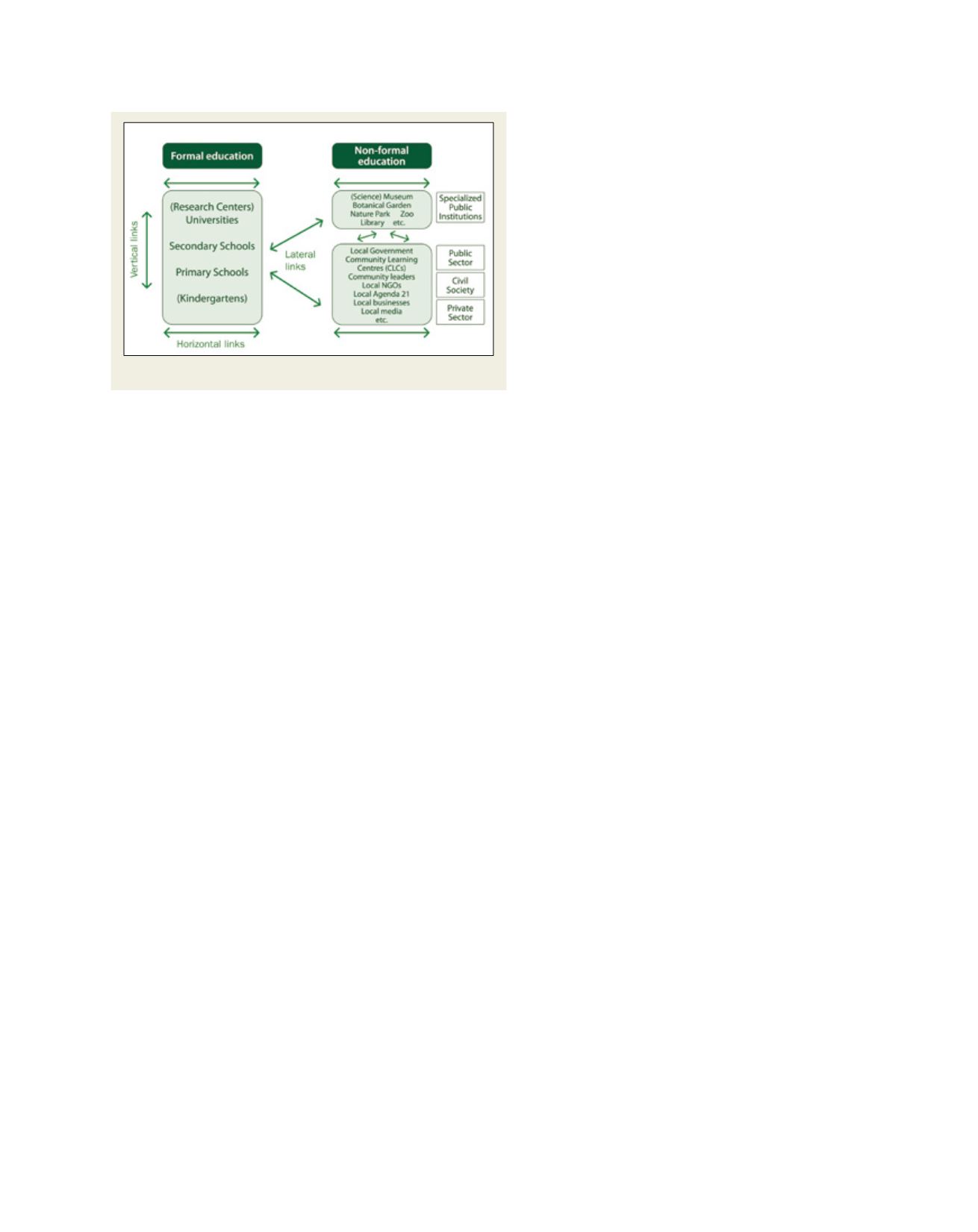

[
] 139
Evolution of the RCE community
Five years after the launch of the first RCEs, the RCE
community has achieved results that are significant,
innovative and often unanticipated by the develop-
ers of the concept. With growing membership – the
community is 77 members strong and growing – the
geographic, thematic and operational partnerships of
RCEs have been established.
Collaboration at the continental level was the first
form of inter-RCE engagement that emerged in a
variety of forms in the Americas, Europe, Africa and
Asia-Pacific. North American RCEs exchange infor-
mation and align their activities through regular
telephone conferences hosted, until recently, by
Environment Canada. African RCEs plan their sub-
regional coordinating meetings in conjunction with
other ESD events, such as those organized by the
Wildlife Society of South Africa (WESSA). The recent
consultation among African RCEs revealed the need
for an additional online communication platform that
would assist experience exchange between the meet-
ings and connect RCEs in various regions of Africa.
European and Asia-Pacific RCEs meet at the annual
face-to-face meetings hosted, in turn, by individual
RCEs. Communication across continents occurs
during the annual International RCE conferences
organized by the United Nations University Institute
of Advanced Studies (UNU-IAS), through the use of
ICT tools and projects and thematic activities.
The operational activities of RCEs are centred
around issues like fundraising, communication and
assessment. Working groups on each of these topics
comprise RCE representatives who bring into discus-
sion perspectives, concerns and lessons from their
regions. The annual meeting of RCEs provides an
opportunity to develop elements of operational strate-
gies that are later acted upon by the Global RCE Service
Centre at UNU-IAS and by the RCEs that have taken
on the responsibility of implementation. The topic
of assessment, in particular, has sparked the interest
of RCEs and those interested in their performance.
In-depth discussion among the partners has led to
the understanding that complex, dynamic and diverse
networks of RCEs would need a flexible and enabling
assessment system. Such a system, grounded in the
notions of self-assessment, networking, participation,
progressive learning and the importance of different
dimensions of sustainability, has been designed and is
currently being tested by RCEs.
Thematic collaboration among RCEs is guided by
generically defined topics such as biodiversity, health,
climate, sustainable production and consumption,
poverty, youth, e-learning, teacher training for ESD
and institutions of higher education. RCEs are primarily
responsible for defining priorities for actions and
modus
operandi
in each of the themes. Working with thematic
areas is not seen as compartmentalization of ESD but as
a way to understand and pursue a particular challenge,
for example health, in the context of ESD. It is also a
appropriate, flexible and innovative actions rather than rigidly formu-
lated norms for what should be done and achieved. Criteria for RCE
acknowledgement give local stakeholders the opportunity to design
an institutional mechanism for mobilization, coordination and learn-
ing that best fits the regional realities and ambitions.
While the geographical scope of RCE operations is defined by the
stakeholders, it has to satisfy a requirement of being large enough to
allow diversity and significance in the number of participating part-
ners but small enough to allow face-to-face interaction among them.
With rare exceptions, RCEs operate within sub-national territories
such as Saskatchewan (Canada), Wales (UK), Crete (Greece), Cebu
(Philippines) and KwaZulu Natal (South Africa).
Having local/regional educational and research actions as their primary
concern, RCEs contribute to the development of the Global Learning
Space (GLS) through exchange of experiences, collaborative research and
educational projects within and outside the RCE community.
In 2006, the Ubuntu Alliance – the consortium of leading inter-
national organizations representing educational and research
institutions – established the Committee of Peers for RCEs. The
Committee reviews applications for new RCEs and provides recom-
mendations to the UNU during the RCE acknowledgement process.
Advice from organizations that are considered leaders in the areas
of science, technology and ESD facilitates alignment of the RCEs’
goals with the broader DESD agenda and strategic implementation
of these goals.
In order to join the global RCE community, a network of local
stakeholders of ESD needs to address the following essential
elements of an RCE:
• Governance: establishment of governance principles and coordi-
nation mechanism among the partners
• Collaboration: engagement of both formal and non-formal
education organizations and a diverse array of partners, so that
the RCE addresses all three dimensions of sustainable develop-
ment (environment, economy and society) as a network
• Research and Development (R&D): incorporation of R&D activ-
ities to enhance ESD practices and to address capacity-building
for sustainability challenges in the region
• Transformative Education: awareness raising, training, and
reorientation of existing education for transition towards
sustainability.
Collaborative links within an RCE
Source: UNU-IAS
















